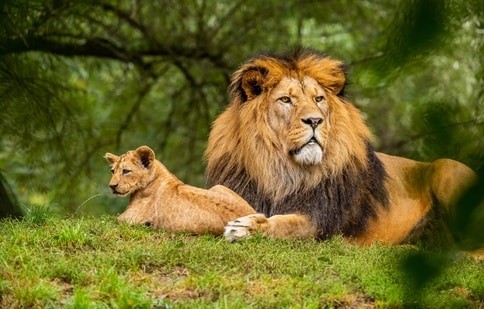
Disclaimer: Copyright infringement not intended.
Context
- World Lion Day is observed on August 10 each year.
Details
History
- Established in 2013 by Big Cat Rescue, the world’s largest accredited sanctuary dedicated to lions, World Lion Day was co-founded by Dereck and Beverly Joubert.
- The Jouberts recognized the urgent need to raise awareness about the declining lion populations and the threats they faced in the wild.
- In partnership with National Geographic, they launched the Big Cat Initiative (B.C.I.) to protect big cats, including lions.
- Since its inception, World Lion Day has been observed annually on August 10 to draw attention to lion conservation issues and to celebrate the majesty and significance of these iconic big cats.
Significance
- World Lion Day serves as a rallying point for supporting and taking action to secure the future of lions in the wild.
- By spotlighting lions and their conservation needs, the day educates people about the vital role lions play in ecosystems and their cultural importance.
- With the urgency of conservation efforts, World Lion Day emphasizes the need to protect these majestic creatures.
Introduction to Lions
- Lions (Panthera leo) are among the most iconic and revered animals on Earth, symbolizing strength, courage, and nobility.
- These large carnivorous mammals are known for their majestic appearance, social behavior, and role as apex predators in their native habitats.
Physical Characteristics
- Size and Build: Adult lions are characterized by their impressive size. Males are larger than females, with average lengths ranging from 9 to 10 feet (2.7 to 3 meters) and standing shoulder heights of around 4.5 to 5.5 feet (1.4 to 1.7 meters). Males can weigh between 330 to 500 pounds (150 to 230 kilograms), while females typically weigh around 260 to 400 pounds (120 to 180 kilograms).
- Manes: One of the most recognizable features of male lions is their majestic manes. The mane ranges in color from blond to black and varies in size and density. It serves as a sign of maturity and dominance, influencing their social status.
- Coat and Coloration: Lions have short fur that varies in color from light tan to golden-yellow, helping them blend into their natural habitat. The underside is generally lighter, and some lions develop faint spots as cubs, which may fade as they grow.
Habitat and Range
- African Habitat: Lions are native to sub-Saharan Africa and once roamed across large parts of the continent. They inhabit a range of habitats, including grasslands, savannas, open woodlands, and scrublands.
- Historical Range: Historically, lions were found across Africa, Asia, and even parts of Europe. However, due to habitat loss, human activities, and conflicts, their range has significantly diminished.
Social Behavior and Lifestyle
- Pride Structure: Lions are unique among big cats for their social structure. They live in groups called prides, which typically consist of related lionesses and their cubs, as well as a few adult males known as coalition members.
- Territorial Nature: Prides defend territories against other lions, especially rival prides and nomadic males. A dominant coalition of males often forms alliances to protect and maintain their territory.
Hunting and Diet
- Apex Predators: Lions are apex predators, meaning they are at the top of the food chain. They prey on a variety of animals, including ungulates like wildebeest, zebras, and antelopes. They can also take down larger prey like buffalo and giraffes.
- Hunting Strategies: Lionesses are primarily responsible for hunting. They use teamwork and strategy to ambush and overpower their prey, often relying on the element of surprise.
Conservation Status and Threats
- Vulnerable Status: Lions are currently listed as "Vulnerable" on the International Union for Conservation of Nature (IUCN) Red List. Their populations have declined due to habitat loss, human-wildlife conflict, poaching, and disease.
- In some parts of Africa, lions are classified as “critically endangered” because lion populations are still plummeting at an unprecedented rate. Asiatic Lion is considered an endangered species.
- Habitat Loss: Human activities such as agriculture, urbanization, and industrial development have resulted in the loss and fragmentation of lion habitats.
- Human-Wildlife Conflict: Lions occasionally come into conflict with local communities due to livestock predation, leading to retaliatory killings that threaten their populations.
- Conservation Efforts: Various organizations, governments, and conservationists are working to protect lions through habitat preservation, community engagement, anti-poaching measures, and education.
Cultural and Symbolic Significance
- Cultural Importance: Lions have held cultural significance throughout history. They are often used as symbols of power, courage, and royalty in various cultures and societies.
- Heraldry and Flags: Lions appear on coats of arms, national flags, and emblems of countries, symbolizing strength and national identity.

Main Lion Species
African Lion (Panthera leo leo): The African lion is the most well-known and widely recognized type of lion. It inhabits various regions across sub-Saharan Africa and was historically spread across a larger range. African lions are known for their social behavior, living in prides consisting of lionesses, cubs, and a few male lions.
Asiatic Lion (Panthera leo persica): Also known as the Indian lion, the Asiatic lion is a subspecies native to the Gir Forest National Park in the western state of Gujarat, India. These lions are slightly smaller than their African counterparts and have a distinctive longitudinal fold of skin along their bellies. Asiatic lions once roamed across parts of Asia but are now critically endangered and confined to a single location.
Barbary Lion (Panthera leo leo): The Barbary lion, also known as the North African lion, was historically found in North Africa, including regions like Morocco and Egypt. However, the last confirmed sighting of a wild Barbary lion was in the 20th century. Some efforts are being made to identify potential descendants of this subspecies in captivity and reintroduce them into the wild.
Cape Lion (Panthera leo melanochaita): The Cape lion was once found in South Africa. This subspecies is considered extinct, with the last known wild individual reportedly shot in 1858. The Cape lion had a unique maneless appearance, making it distinct from other lions.
Masai Lion (Panthera leo nubica): The Masai lion, also known as the East African lion, is found in East Africa, including countries like Kenya and Tanzania. It is known for its larger size and darker mane compared to other African lions.
Transvaal Lion (Panthera leo krugeri): The Transvaal lion, often referred to as the South African lion or Kruger lion, is found in the southern parts of Africa, including Kruger National Park in South Africa. It's considered one of the larger subspecies of lions.
West African Lion (Panthera leo senegalensis): This subspecies is found in West Africa and is adapted to the savannas and grasslands of the region. West African lions are relatively smaller and have a lighter coat compared to other subspecies.
Lions in India
- Lions, once widespread across India, now have a limited presence in the country.
- The Asiatic lion (Panthera leo persica) is a distinct subspecies found only in the Gir Forest National Park and Wildlife Sanctuary in the state of Gujarat, India.

Historical Distribution
- Extensive Range: Historically, lions were found in various parts of India, including regions such as Rajasthan, Uttar Pradesh, and Madhya Pradesh. They were depicted in ancient Indian art, literature, and sculptures, signifying their significance in the culture.
- Range Contraction: Over the centuries, habitat loss, hunting, and human activities led to the decline of lion populations in India. By the early 20th century, the only remaining population was in the Gir Forest of Gujarat.
The Gir Forest and Asiatic Lions
- Sole Habitat: The Gir Forest National Park and Wildlife Sanctuary, established in 1965, is the last refuge of the Asiatic lion. This protected area covers approximately 1,412 square kilometers and provides critical habitat for the survival of these lions.
- Distinct Characteristics: Asiatic lions have a slightly smaller size and a distinctive longitudinal fold of skin along their bellies. They have adapted to the dry deciduous forests and savannas of the Gir region.
- Conservation Challenges: The concentration of lions in one area makes them vulnerable to disease outbreaks, natural disasters, and other threats. Ensuring genetic diversity and preventing inbreeding are ongoing concerns.
Asiatic Lion Reintroduction Project
- The Asiatic Lion Reintroduction Project is a significant initiative by the Indian Government aimed at securing the survival of the Asiatic lion from extinction in the wild through reintroduction efforts.
- The project addresses the vulnerability of the last remaining population of Asiatic lions, which resides in the Gir Forest National Park in Gujarat.
- Threats such as epidemics, natural disasters, and human activities necessitate the creation of a second independent population to ensure the species' survival.
Historical Context and Proposed Reintroduction Site
- Current Habitat and Overpopulation: The Asiatic lion population in the Gir Wildlife Sanctuary has rebounded from a mere 18 individuals in 1893 to over 523 in 2015. Overpopulation, competition with humans for space and resources, and increasing human-animal conflicts have driven the need for a new habitat.
- Reintroduction Site: The Kuno National Park in Madhya Pradesh has been identified as the site for the proposed reintroduction. This site aims to establish a new population of Asiatic lions, reducing the pressure on the Gir Wildlife Sanctuary and ensuring the survival of the species.
Historical Attempts and Failures
- Sheopur Introduction (1904): In 1904, the Maharaja of Gwalior attempted to introduce African lions in the wild near Sheopur. However, these lions turned to raiding livestock and became man-eaters, leading to their eventual elimination.
- Chandraprabha Relocation (1957): In 1957, one lion and two lionesses from Gir were translocated to the Chandra Prabha Sanctuary in Uttar Pradesh. While their numbers increased initially, the population eventually died out due to factors such as inadequate area, lack of monitoring, and conflicts with local herders.
Wildlife Institute of India Initiative
- The Wildlife Institute of India (WII) began studying the Asiatic lions in 1986 to collect crucial data on their behavior, habitat use, and feeding patterns.
Project Lion
Launched on August 15, 2020, by Indian Prime Minister Narendra Modi, Project Lion aims to conserve the Asiatic lion species. Similar to Project Tiger, it focuses on breeding sites called "gene pools" at Rampara, Sakkarbaug, and Satveerada. The project also addresses human-wildlife conflicts and identifies potential reintroduction sites.
Potential Reintroduction Sites
The project has identified six potential sites for reintroducing the Asiatic lion:
-
- Madhav National Park, Madhya Pradesh
- Sitamata Wildlife Sanctuary, Rajasthan
- Mukundra Hills Tiger Reserve, Rajasthan
- Gandhi Sagar Wildlife Sanctuary, Madhya Prades
- Kumbhalgarh Wildlife Sanctuary, Rajasthan
- Jessore-Balaram Ambaji WLS and adjoining landscape, Gujarat
Project Framework and Phases
-
- The Lion Introduction Project's framework emerged from a Monitoring Committee's transformation, established by the Indian Government.
- The project follows a three-phase approach:
- First Phase (1995-2000): Shifting villages out of the sanctuary, habitat improvement.
- Second Phase (2000-2005): Fencing the reintroduction site, actual translocation, research, and monitoring.
- Third Phase (2005-2015): Eco-development of the region.

Conclusion
Lions stand as magnificent creatures, embodying the spirit of the wild. Their majestic appearance, social behaviors, and vital role in maintaining ecosystems make them an integral part of the natural world. However, the challenges they face due to human impact highlight the urgent need for conservation efforts to ensure that future generations can continue to admire these regal predators in their natural habitats.
|
PRACTICE QUESTION
Q. Discuss the challenges and initiatives undertaken by the Indian government for the conservation of the Asiatic Lion. How does the Asiatic Lion Reintroduction Project aim to address these challenges? Examine its significance in preserving this iconic species and the efforts made to ensure its coexistence with local communities. (250 Words)
|
https://www.hindustantimes.com/lifestyle/festivals/world-lion-day-2023-date-history-significance-and-celebration-101691502505698.html













